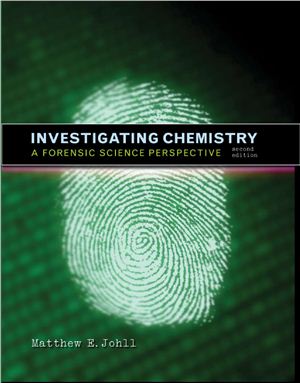2nd ed. W.H.Freeman and Company. 2009. 508 p.
In its new second edition, Investigating Chemistry: A Forensic Science Perspective remains the only book that uses the inherently fascinating topics of crime and criminal investigations as a context for teaching the fundamental chemical concepts most often covered in an introductory nonmajors course. Covering all the standard topics, Matthew Johll capitalizes on the surge of interest in the scientific investigation of crime (as sparked by CSI and other television shows), bringing together the theme of forensic science and the fundamentals of chemistry in ways that are effective and accessible for students.
This edition features refined explanations of the chemical concepts, which are the core of the book, as well as a more thoroughly integrated forensic theme, updated features, and an expanded media/supplements package.
Contents
Introduction to Forensic Chemistry
Evidence Collection and Preservation
Atomic Clues
Chemical Evidence
Chemistry of Bonding: Structure and Function of Drug Molecules
Properties of Solutions I: Aqueous Solutions
Properties of Solutions II: Intermolecular Forces and Colligative Properties
Drug Chemistry
Arson Investigation
Chemistry of Explosions
Estimating the Time of Death
The Nuclear Age: Energy, Medicine, Weapons, and Terrorism
Poisons
Identifi cation of Victims: DNA Analysis
In its new second edition, Investigating Chemistry: A Forensic Science Perspective remains the only book that uses the inherently fascinating topics of crime and criminal investigations as a context for teaching the fundamental chemical concepts most often covered in an introductory nonmajors course. Covering all the standard topics, Matthew Johll capitalizes on the surge of interest in the scientific investigation of crime (as sparked by CSI and other television shows), bringing together the theme of forensic science and the fundamentals of chemistry in ways that are effective and accessible for students.
This edition features refined explanations of the chemical concepts, which are the core of the book, as well as a more thoroughly integrated forensic theme, updated features, and an expanded media/supplements package.
Contents
Introduction to Forensic Chemistry
Evidence Collection and Preservation
Atomic Clues
Chemical Evidence
Chemistry of Bonding: Structure and Function of Drug Molecules
Properties of Solutions I: Aqueous Solutions
Properties of Solutions II: Intermolecular Forces and Colligative Properties
Drug Chemistry
Arson Investigation
Chemistry of Explosions
Estimating the Time of Death
The Nuclear Age: Energy, Medicine, Weapons, and Terrorism
Poisons
Identifi cation of Victims: DNA Analysis

